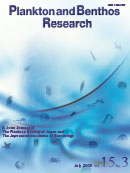15 巻, 3 号
選択された号の論文の10件中1~10を表示しています
- |<
- <
- 1
- >
- >|
Original Papers
-
2020 年15 巻3 号 p. 189-206
発行日: 2020/08/14
公開日: 2020/08/04
PDF形式でダウンロード (33040K) -
2020 年15 巻3 号 p. 207-219
発行日: 2020/08/14
公開日: 2020/08/04
PDF形式でダウンロード (2791K) -
2020 年15 巻3 号 p. 220-227
発行日: 2020/08/14
公開日: 2020/08/04
PDF形式でダウンロード (3283K) -
2020 年15 巻3 号 p. 228-231
発行日: 2020/08/14
公開日: 2020/08/04
PDF形式でダウンロード (1759K) -
2020 年15 巻3 号 p. 232-237
発行日: 2020/08/14
公開日: 2020/08/04
PDF形式でダウンロード (3224K) -
2020 年15 巻3 号 p. 238-249
発行日: 2020/08/14
公開日: 2020/08/04
PDF形式でダウンロード (2356K) -
2020 年15 巻3 号 p. 250-258
発行日: 2020/08/14
公開日: 2020/08/04
PDF形式でダウンロード (837K) -
2020 年15 巻3 号 p. 259-268
発行日: 2020/08/14
公開日: 2020/08/04
PDF形式でダウンロード (23202K) -
2020 年15 巻3 号 p. 269-278
発行日: 2020/08/14
公開日: 2020/08/04
PDF形式でダウンロード (840K) -
2020 年15 巻3 号 p. 279-288
発行日: 2020/08/14
公開日: 2020/08/04
PDF形式でダウンロード (673K)
- |<
- <
- 1
- >
- >|
